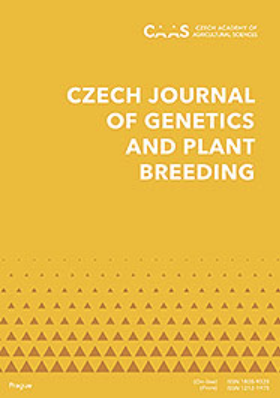花楸法尼基转移酶α-亚基基因CrFTA在亚洲解放候选杆菌感染后的表达变化
IF 1.8
4区 农林科学
Q3 AGRONOMY
引用次数: 2
摘要
法尼基转移酶α-亚基(FTA)可能参与调控植物对病原体的防御反应。本研究从玫瑰Catharanthus roseus (CrFTA基因)中扩增出该基因。该cDNA全长1 403 bp,编码一个含有保守PPTA基序的331个氨基酸的蛋白。系统发育分析表明,CrFTA序列与咖啡canephora最相似。qRT-PCR分析表明,CrFTA在叶、茎和根中均有表达。在亚洲自由Candidatus Liberibacter asiaticus (Ca. L. asiaticus)感染期间,CrFTA表达量显著升高,达到对照组的18倍,之后从顶部嫁接(DAT)后22天至实验结束,其表达量逐渐下降。喷施法尼基转移酶特异性抑制剂马奴霉素A (Manumycin A, ManuA)后,与未喷施ManuA的处理组相比,嫁接后的亚洲Ca. L. asiaticus的CrFTA表达量显著降低,阳性百分率显著提高。此外,ABA对亚洲Ca. L. asiaticus阳性植株数量和CrFTA的相对表达量没有显著影响。这些结果表明,CrFTA很可能介导了玫瑰玫瑰对亚洲镰刀菌感染的耐受性。本文章由计算机程序翻译,如有差异,请以英文原文为准。
Changes in the expression of CrFTA, the Catharanthus roseus farnesyltransferase α-subunit gene, in response to a Candidatus Liberibacter asiaticus infection
The farnesyltransferase α-subunit (FTA) may be involved in the regulation of defence responses against pathogens in plants. In this study, this gene was amplified from Catharanthus roseus (CrFTA gene). The cDNA was found to be 1 403 bp long, and encodes a putative protein of 331 amino acids that contains a conserved PPTA motif. The phylogenetic analysis showed that the sequence of CrFTA is the most similar to that from Coffea canephora. The qRT-PCR assays indicated that CrFTA is expressed in the leaves, stems, and roots. During a Candidatus Liberibacter asiaticus (Ca. L. asiaticus) infection, the CrFTA expression levels significantly increased and reached 18-fold that measured in the control group, after which its expression decreased gradually from 22 days after top-grafting (DAT) to the end of the experiment. Spray application of Manumycin A (ManuA), a specific inhibitor of farnesyltransferase, on the leaves of C. roseus plants caused a significant decrease in the CrFTA expression and a significant increase in the Ca. L. asiaticus positivity percentage after top-grafting with the Ca. L. asiaticus-infected shoots compared with the groups not treated with ManuA. Furthermore, ABA had no significant effect on the relative expression of CrFTA and the number of Ca. L. asiaticus-positive plants. These results suggest that CrFTA most likely plays a role in mediating the tolerance to a Ca. L. asiaticus infection in C. roseus.
求助全文
通过发布文献求助,成功后即可免费获取论文全文。
去求助
来源期刊

Czech Journal of Genetics and Plant Breeding
Agricultural and Biological Sciences-Plant Science
CiteScore
2.20
自引率
0.00%
发文量
25
审稿时长
>12 weeks
期刊介绍:
Original scientific papers, critical reviews articles and short communications from the field of theoretical and applied plant genetics, plant biotechnology and plant breeding. Papers are published in English.
 求助内容:
求助内容: 应助结果提醒方式:
应助结果提醒方式:


